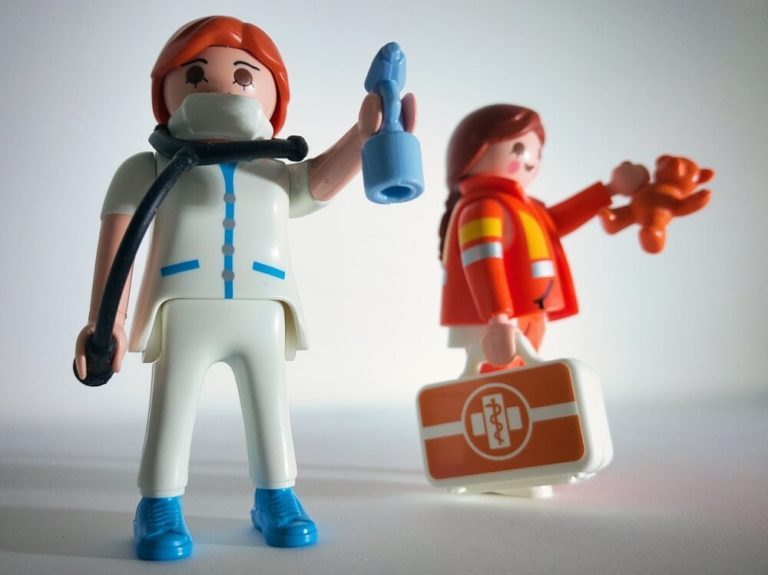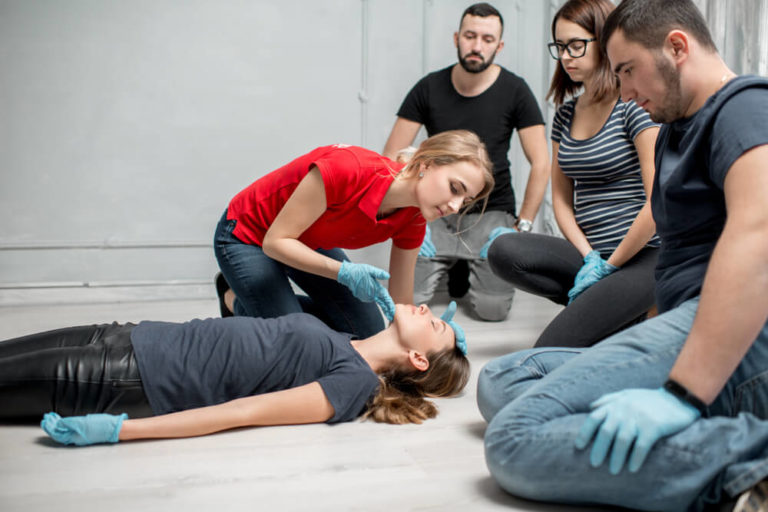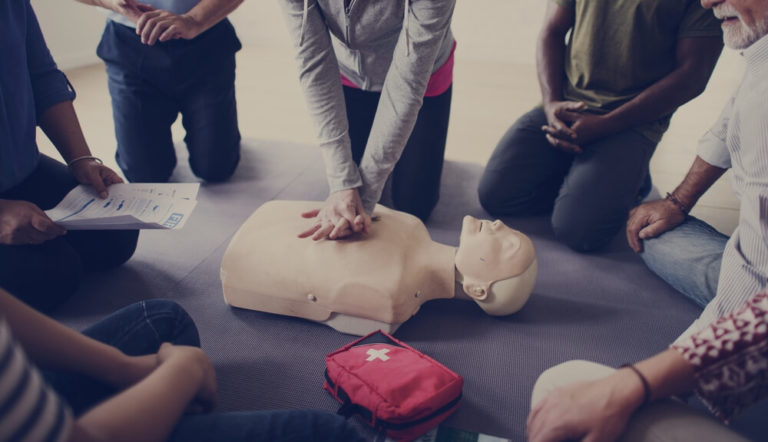
Have you ever wondered what might happen during a sudden accident at your workplace? Or have you imagined if you’d be helpful enough to a colleague undergoing a sudden cardiac arrest? Well, these are not our average everyday fantasies. However, these can be very probable situations. Every year, many workplaces suffer tremendous losses from accidents of various kinds. Hence, first aid training at your workplace is of pivotal importance. This could literally be the difference between your or your colleague’s life and death.
So, to learn more about first aid training at your workplace and some very helpful techniques, stay with us.
Table of Contents
What Is First Aid?
Have you ever faced a medical emergency? Do you recall finding someone in a dire situation but lacking any clue on what should you do?

Well, that is where the concept and practice of first aid come in. When there is a state of serious sickness or injury, the affected person needs urgent access to medical care. However, sometimes the time needed to access a formal medical setup can be very short. Therefore, the right care within this small-time window can eliminate grave risks. Such care that an affected person receives before formal medical treatment is called first aid.
First aid can sometimes be the difference between life and death. Least of all, it can prevent serious health setbacks. Examples of first aid steps can range from covering wounds to providing CPR and beyond. Another key point to remember here is the importance of training. For being a first aid responder, receiving training and certification beforehand is important.
First Aid Training At Your Workplace- What Makes It So Important?
Does first aid at the workplace make a difference? Will first aid training at your workplace amount to something real? The answer is, yes, it will. Even if there is no big accident at your workplace, first aid training at your workplace will still make a significant difference. Here are the reasons:
1. Cost-Effectiveness
An estimated £5.6 billion goes into workplace accidents every year in the UK alone. And sadly, an awful lot of them are preventable. Do you want to bear that kind of unwanted and preventable expense? If not, then you might want to invest in first aid training at your workplace.
2. Boosting Employee Morale And Retention
When you invest in the well-being of your employees, they will feel cared for. And that will eventually lead to better workplace happiness.

3. Improving Workplace Productivity
This is linked to the factor described above. When your employees are happy and healthy, they will eventually be more focused and dedicated at the workplace.
4. Avoiding Potential Impediments
Most importantly, when your employees are sick and injured, important work hours are lost. In addition, it can drastically bring down your employees’ morale.
So to conclude, investing in first aid training at your workplace is not only a great idea but also a very necessary one.
What Are The 3P’s In First Aid?
An easy way to remember the main objective of providing first aid care is ‘The 3 P’s’. The 3 P’s are:
1. Preserve life
2. Prevent deterioration
3. Promote recovery
To achieve each of these three goals step by step, here is a basic guideline that you can follow.
The First P’ Of First Aid- Preserve Life
Are you confused thinking of what actions can possibly ensure ‘preserving life’ by now? Well, that’s understandable. In short, it means doing one’s best to keep the patient breathing.
So before doing this, the responder needs to take a quick scan at the scene of the accident. Once the surrounding environment seems safe, they can resort to the C-A-B method of first aid. For remembering this the easier way, you can also remember the acronym as ‘The ABC method’.
C for Circulation
The circulation of blood to our vital organs is a prerequisite for staying alive. That’s because oxygen is transported to different parts of the body through blood circulation.
Hence, if a person’s circulation seems to be inadequate, then the responder needs to intervene accordingly. For example, doing chest compressions. There is more on the CPR process below for a better understanding of this step.
A For Airway
Unless a person’s airway is clear, they can’t breathe properly. So the responder might want to help the casualty by clearing the airway. This is especially important if they seem to be breathing inadequately. To do this, the responder has to place one hand’s fingers on the casualty’s forehead. Then, they have to gently lift the casualty’s chin with another hand.

B for Breathing
Unless the casualty is breathing, their tissues and organs will soon start to fail. So the responder must check urgently to ensure that the casualty is breathing. The responder then needs to place an ear on top of the casualty’s mouth sideway for doing so. In other words, from this position, the responder can view the rest of the casualty’s body.
While in this position, the responder needs to track these things for checking if the casualty is breathing:
- The sound of breath
- If the casualty’s breath can be felt on the cheek
- Up and down movement of the chest
These should not be monitored for any more than ten seconds. Because it might get too late otherwise. If breathing doesn’t seem okay, the responder should move on to the next step, which is rescue breathing. However, rescue breaths are also effective yet temporary ways to keep the casualty alive. So arrangements for more advanced help should be made without any delay at all.
The Second P Of First Aid- Prevent Deterioration:
After doing everything to ‘preserve life’, the next step is to ‘prevent deterioration’. In other words, the responder should next focus on keeping things from getting worse. For doing this, they can start with moving the patient/victim to a comfortable place and position. Next, the responder can check the injuries and cover them for preventing infection. The responder can also resort to steps for comforting the casualty. They can then apply other known first aid techniques for preventing deterioration.
The Third P’ Of First Aid- Promote Recovery
After ‘preserving life’ and ‘preventing deterioration’, the responder should focus on ‘promoting recovery’. For doing this, the responder might try to keep the casualty as encouraged and motivated as possible. They can also take steps to comfort the victim to the highest extent. And most importantly, the responder needs to help the patient reach professional help without delay.
What Are The Most Common Workplace Medical Hazards, And How To Address Them?
The list of where you could apply your first aid knowledge is potentially endless. Hence, it’s best to learn what are the most common hazards and injuries that happen at workplaces. So, here is a list for you, which is certainly not exhaustive. But knowing the first aid strategies for these will make you potentially more helpful. So here is a shortlist of the common workplace injuries and hazards:
- Cardiac arrests or heart attacks
- Cuts and scrapes, and resultant bleeding
- Burns
- Sprains
- Asthma and choking
- Allergic reactions
- Seizures
- Fractures
- Shock
Bleeding
The first goal for providing first aid for bleeding is preventing further blood loss. For doing so, going through the following steps will help you:
- Gently clean the wound, but don’t wash an open wound with soap or other abrasives.
- Apply antibiotics.
- Keep the wound covered and protected.
- In case of deep wounds, apply pressure for preventing excessive blood loss. Next, use a loose cloth for covering the wound.
- Instead of disposing of the cloth for getting too soaked in blood, wrap over it with more clothes.
Burns
Before taking first aid steps to treat burns, it’s important to recognise the type and degree of burn. Burns can be broadly categorised as major and minor burns.

Types Of Burns:
If elaborated further, burns can be classified into 4 degrees:
1. First degree burns
When the burn affects only the outer layer of skin, we call it a first-degree burn. It usually renders the skin red with some level of swelling.
2. Second-degree burns
Second-degree burns reach the inner layer of the skin. Severe swellings and blisters mark this type of burn. The multi-layered burns of this type are extremely difficult to endure.
3. Third-degree burns
Third-degree burns penetrate all skin layers and reach underneath. Sometimes these injuries can be intense enough to damage nerves and thus damage the victim’s sensations. Consequently, the victim can end up feeling no pain after such intense damage.
4. Fourth-degree burns
Fourth-degree burns reach the inner structure of the body after passing through the tissues. This burn numbs the victim’s sensation due to serious nerve damage.
Minor burns refer to first-degree and light second-degree burns. Major burns refer to serious second-degree to fourth-degree burns.
How To Address Minor Burns?
When you are dealing with a patient with minor burns, focus on cooling the area of injury first. Remove objects such as rings and watches from the wounded area. Hold the injured place under running cool water, or compress it with a loose, cool, and wet wrap.
However, don’t use ice-cold water for this. To explain, ice-cold water or ice might block the blood vessels and obstruct blood circulation. And reduced blood supply can worsen the injury, and even end up further damaging the wounded tissues.
After the wound cools down a little, cover it with a band-aid. Make sure that the band-aid is sterile and non-stick. If blisters form around the wounds, cover them lightly and leave them alone. It’s important to not pop or disturb the blisters.
To soothe the wound, you can apply some mild moisturiser or petroleum jelly. However, beware of giving in to the temptation of applying toothpaste or unknown ointments. In addition, for alleviating pain, you can give the victim some safe over-the-counter medicine such as ibuprofen.
And most importantly, keep the wounded area away from sunlight and heat.
How To Address Major Burns?
Major burns expose the victim or patient to serious health risks. So, the important thing to do here is to prevent deterioration as long as medical help cannot be accessed. And taking the patient to medical help ASAP is the key goal.
- Till medical help can be accessed, don’t attempt applying ointment to the wounded area.
- Remove other objects, such as rings and watches from the wounded area as soon as you can.
- Cover the area with a fabric lightly so that it doesn’t get contaminated further.
- For severe burns, don’t apply water because it can result in fast body heat loss.
- Keep the wounded area lifted to the level of the patient’s heart if that’s feasible.
- Check if the patient’s breathing is okay. If not, follow the procedures of rescue breathing as explained later in this article.
Head And Back Injuries
When a person is suffering from head or back injuries, the first thing to check is if there are other imminent dangers. For example, unless you move the injured person from that place, if there is an increased risk of getting cut or hurt somehow. If there is no such risk, then not moving the injured person till hospital help shows up is the right thing to do (assuming that the condition is serious).

Sprains
Sprains usually don’t come at major health risks or a need for hospitalisation. Often times, steps that you learned at first aid training at your workplace will be sufficient.
For dealing with the resulting swellings, start with cold compressions. Use a piece of ice wrapped in cloth instead of applying it directly to the swelled place. Rather than compressing for a prolonged period, do it in spaced repetition.
What Is CPR? And How To Do It?
CPR or Cardiopulmonary Resuscitation is an emergency procedure. It is performed on someone who is supposedly undergoing Cardiac Arrest. This is a highly effective technique for increasing the patient’s survival probabilities.

CPR has two main steps, namely Compressions and Rescue breathing. Compressions can be performed by an untrained bystander too. For doing so, the responder needs to place the heel or base of one hand on the patient’s chest. Then he has to interlace the fingers of the other hand into the fingers of that hand. Next, employing his body’s strength and weight, the responder needs to apply pressure to the chest. And it should be done in a way that pushes around two inches from the patient’s chest. The speed of compression should be about 100 compressions per minute. A person certified in first aid can also take the help of an AED (Automatic External Defibrillator) machine.
After compression, the next step is to do rescue breaths. Though this step can be performed by any bystander too, it’s best if someone trained can do the procedure. Before doing mouth-to-mouth rescue breathing, the responder needs to help the patient have a clear airway. Next, he has to close the patient’s nostrils by pinching with his fingers. After sealing it, the responder will blow steadily into the patient’s mouth. If the chest rises after breathing into his mouth this way, that means the procedure is successful. If it doesn’t, then the airway needs to be cleared again.
The ratio of compression to rescue breaths should typically be 30:2. The responder should keep repeating this process until the ambulance arrives.
Closing Thoughts On Workplace First Aid
There are a few things that we don’t feel like spending on initially. But by the time we realise its importance, it gets too late. First aid training at your workplace can be a good example of this.
Hopefully, the extensive discussion on first aid training at your workplace and related techniques shed some light on it. And to get more help on teaching yourself and your workplace fellows, check this course on ‘Emergency First Aid at work’ by Compliance Central. It might make a real difference in safety at the workplace someday!
Course Categories
- Workplace Safety
- Travel
- Training
- Therapy
- Technology
- Teaching and Education
- Teaching and Academics
- Teaching
- Stress Management
- Sports
- Safeguarding
- QLS Endorsed
- Public Speaking
- Psychology
- Project Management
- Philosophy
- Personal Development
- Nutrition & Diet
- Mental Health
- Marketing
- Management
- Lifestyle
- Leadership
- Law
- Language
- IT and Software
- Interpersonal Communication
- Intermediate,Employability
- Hospitality
- Healthcare
- Health and Social Care
- Health and Safety
- Health and Fitness
- Hazard Awareness
- Forensic Science
- Food Safety
- Food Hygiene
- Food & Beverage
- First Aid
- Fire Safety
- Fashion Design
- Fashion
- Environment
- Entrepreneurship
- Engineering
- Employability
- Electronics
- Electrical Safety
- Education
- Development
- Design
- Data Science
- Counselling
- Cooking
- Construction
- Communication
- Cleaning
- Child Psychology
- Child Care
- Business Skills
- Business Skill
- Business
- Awareness
- Assertiveness
- Animal Care
- Agriculture
- Accounting and Finance


0 responses on "First Aid Techniques: A Guide for Workplace First Aid"